Join our Larry McDonald on CNBC’s Trading Nation, Wednesday at 3:05pm ET
Pick up our latest report here:
Don’t miss our next trade idea. Get on the Bear Traps Report Today, click here“We believe inflation is set to finally pick up in 2018. Much of the passive and quant-side (a $1.5T shift in asset management) has become heavily invested in the “risk parity” model which involves being long equities and bonds on a risk-adjusted basis. One of the fundamental problems with this strategy is you’re effectively really long disinflation. Sure, it’s worked very well in the post great financial crisis period, but it’s a grossly crowded trade and has all the makings of a gruesome slaughterhouse. In this case, the risk tail is a period where equities and bonds fall together, which is not that uncommon in a late cycle inflationary environment (see 1980s and 1990s). Other than out of the money puts in rates (bonds) a big way for these guys to hedge inflation is to increase commodity exposure. As long-time bulls, we’re now ‘pounding the table’ bond bears for 2018.”
Bear Traps Report, January 2, 2018
This week’s FOMC meeting marked Janet Yellen’s final meeting as Chairwoman of the Federal Reserve.
The Long Bond, on a Key Technical Level
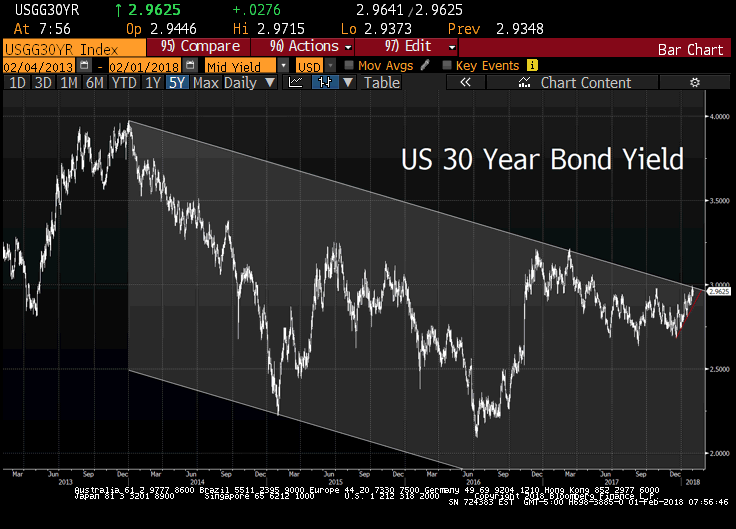
The US 10 year has already broken the trend line above. Fed policy, strong global growth and the new kid on the block, US fiscal policy have driven the latest round of selling. Pick up our latest Bear Traps Report for our detailed investment thesis of 2018.
No rate hike was expected at this week’s meeting, and none came, leaving the midpoint target level at 1.375%. The next 25bp increase – up to 1.50%-1.75% from 1.25%-1.5% – will come, in all likelihood, at the March meeting with Chairman-elect Jerome Powell at the helm.
Inflation Expectations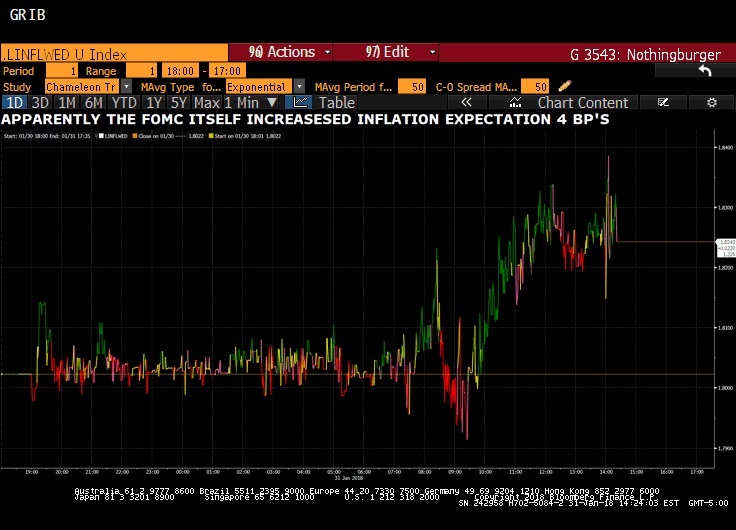
The big news of the day (see above) came when the Fed raised near-term inflation outlook to above two percent, driving the two-year bond yield even higher, while the long end (30s) rallied, thus more flattening.
The probability of rate hikes in 2019 has doubled since the last FOMC meeting:
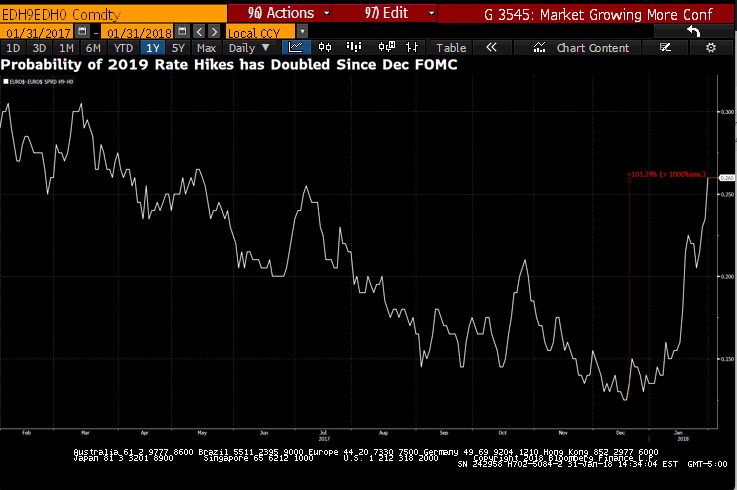 The thing to keep your eye on, in our opinion, is the probability of four hikes in 2018, instead of the three (the recent consensus). The Street was hawkish today before the meeting. Much of the debate comes from the Fed’s word choice on near-term risks to the economic outlook. The Fed reiterates these risks as “roughly balanced,” a nod away from Goldman Sachs’ expectations that these risks would now be just “balanced”. Chair Yellen left today as dovish as she came, and the Street is looking at the Powell team as by definition, more hawkish (more likely to pull back accommodation).
The thing to keep your eye on, in our opinion, is the probability of four hikes in 2018, instead of the three (the recent consensus). The Street was hawkish today before the meeting. Much of the debate comes from the Fed’s word choice on near-term risks to the economic outlook. The Fed reiterates these risks as “roughly balanced,” a nod away from Goldman Sachs’ expectations that these risks would now be just “balanced”. Chair Yellen left today as dovish as she came, and the Street is looking at the Powell team as by definition, more hawkish (more likely to pull back accommodation).
Pick up our latest report here:
Don’t miss our next trade idea. Get on the Bear Traps Report Today, click hereThe probability of four or more rate hikes in 2018:
Jan 24%
Dec 5%
Nov 3%
Bloomberg data
Data-dependent, gradual raising Yellen hands the baton today over to a similarly data-dependent Powell. However, if the data (recently firming prices and slightly higher, yet still sub-2%, PCE) is allowed to speak for itself, it was reasonable to expect a hawkish tone in today’s statement.
Today’s Chicago PMI printed 65.7, soundly beating the consensus estimate of 64, yet lower than the unsustainable prior-revised 67.8. Upcoming significant data releases include Jobless Claims and Nonfarm Payrolls, on Thursday and Friday respectively.
Yellen, while ill-advised to act based on market prices has a history of mentioning “rich asset valuations”, and must be keeping her eye on the technically-overbought S&P 500, which, even with this week’s move off the highs, is up 5% YTD, or an annualized rate of 83%. NY Fed President Dudley recently expressed concern about the possibility of an “overheating” economy that appears to be stretching its cycle after the passage of tax reform.

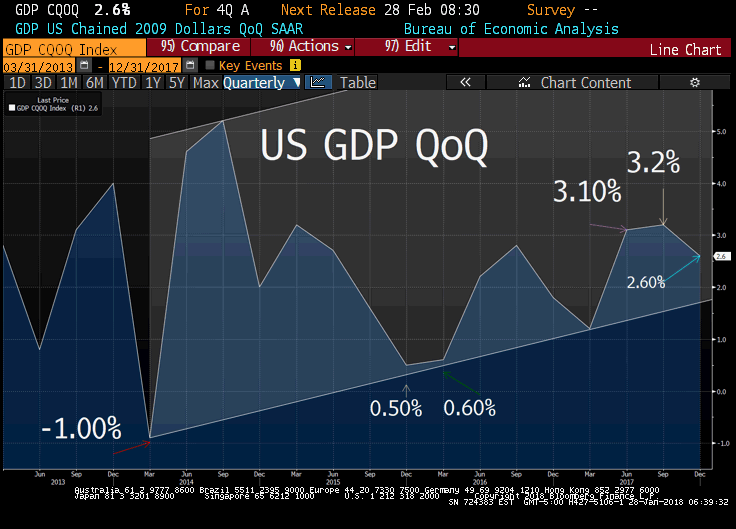 The 2.6 percent headline rate doesn’t do justice to fourth-quarter GDP where consumer spending rose a very strong 3.8 percent that reflects a 14.2 percent burst in durable spending. Bloomberg noted Residential investment, which is another consumer-related component, rose at a very impressive 11.6 percent annualized rate. Turning to business spending, nonresidential fixed investment rose at a 6.8 percent rate which is the fourth straight mid-single digit result.
The 2.6 percent headline rate doesn’t do justice to fourth-quarter GDP where consumer spending rose a very strong 3.8 percent that reflects a 14.2 percent burst in durable spending. Bloomberg noted Residential investment, which is another consumer-related component, rose at a very impressive 11.6 percent annualized rate. Turning to business spending, nonresidential fixed investment rose at a 6.8 percent rate which is the fourth straight mid-single digit result.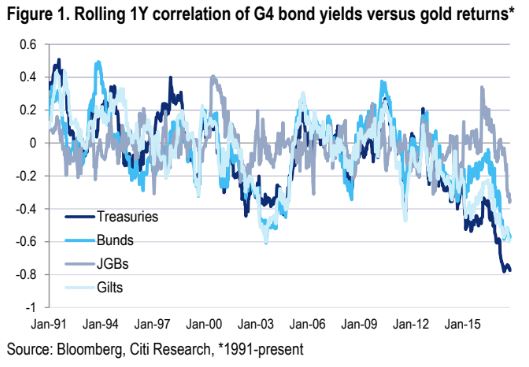
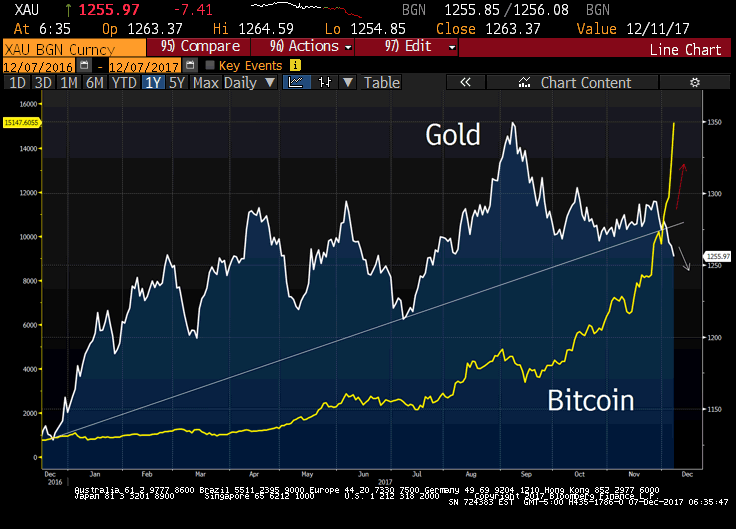 The total amount of gold above ground is 190K tonnes or $6Tr at current value. Half of that is in jewelry so left with $3Tr. Half of that is in reserves at central banks so that leaves a physical gold market size available to investors of $1.5tr (excl derivatives). Today, total cryptos are remarkably 23% of gold liquid (physical) market capitalization. The total value of all cryptocurrencies out is now $350bl of which bitcoin $250bl. So cryptos are 23% of physical gold available to investors now.
The total amount of gold above ground is 190K tonnes or $6Tr at current value. Half of that is in jewelry so left with $3Tr. Half of that is in reserves at central banks so that leaves a physical gold market size available to investors of $1.5tr (excl derivatives). Today, total cryptos are remarkably 23% of gold liquid (physical) market capitalization. The total value of all cryptocurrencies out is now $350bl of which bitcoin $250bl. So cryptos are 23% of physical gold available to investors now.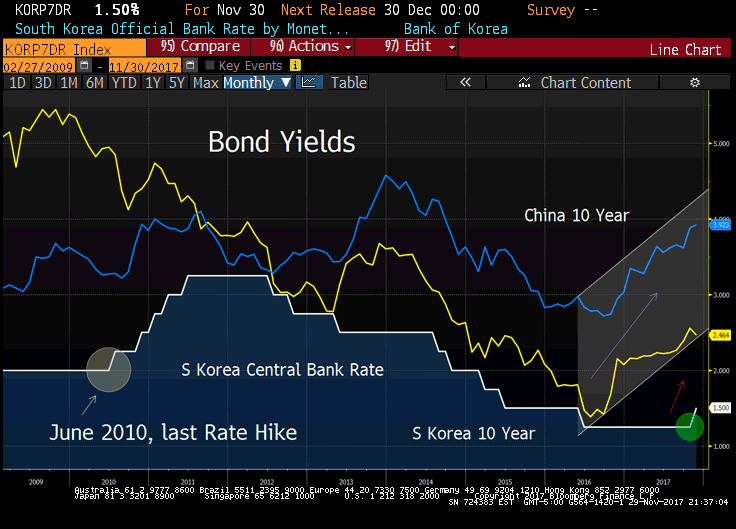 Thursday’s decision to raise the seven-day repurchase rate to 1.5 percent was forecast by 18 of 24 analysts surveyed by Bloomberg. The rest expected the central bank to leave the rate at a record-low 1.25 percent, where it has been since June 2016. As you can see above, markets widely anticipated this move – interest rates in China and S Korea have been on the rise for 15 months.
Thursday’s decision to raise the seven-day repurchase rate to 1.5 percent was forecast by 18 of 24 analysts surveyed by Bloomberg. The rest expected the central bank to leave the rate at a record-low 1.25 percent, where it has been since June 2016. As you can see above, markets widely anticipated this move – interest rates in China and S Korea have been on the rise for 15 months. 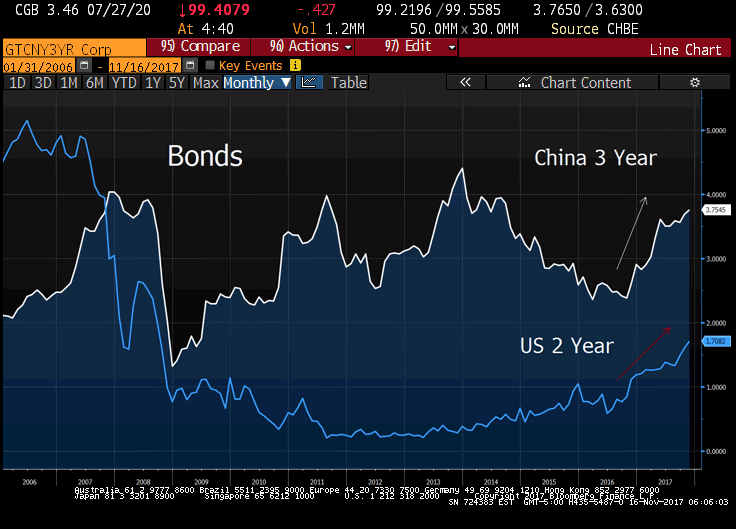 This week’s fears pushed China government bond yields to a 3-year high, taking U.S. two year Treasury bond yields north with them.
This week’s fears pushed China government bond yields to a 3-year high, taking U.S. two year Treasury bond yields north with them.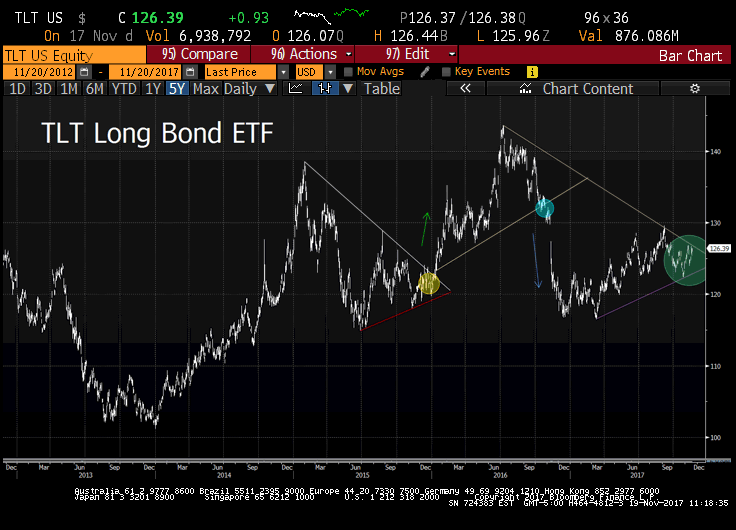 iShares 20+ Year Treasury Bond ETF seeks to track the investment results of an index composed of U.S. Treasury bonds with remaining maturities greater than twenty years. Over the last decade, wedge breaks in the technical chart pattern of the TLT have led to large moves in interest rates. Today. an important wedge is near a breach again, a true Bull – Bear battleground is forming (middle right above).
iShares 20+ Year Treasury Bond ETF seeks to track the investment results of an index composed of U.S. Treasury bonds with remaining maturities greater than twenty years. Over the last decade, wedge breaks in the technical chart pattern of the TLT have led to large moves in interest rates. Today. an important wedge is near a breach again, a true Bull – Bear battleground is forming (middle right above). 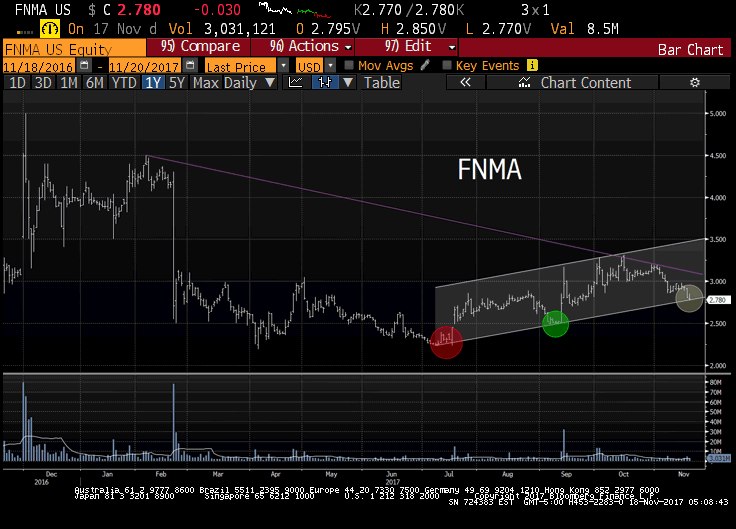 Bill Ackman’s Pershing Square Capital Management owns 44.7 million shares of FNMA, per the Bloomberg terminal. The LIFO cost basis is listed at $3.37 acquired over the last two years. This week, shares closed below their 200-day moving average. In the past five years, Fannie Mae crossed below this level 26 times and fell an average 1.7 percent in the next five days. It declined 17 times for an average loss of 3.9 percent, and advanced eight times for an average gain of 2.9 percent.
Bill Ackman’s Pershing Square Capital Management owns 44.7 million shares of FNMA, per the Bloomberg terminal. The LIFO cost basis is listed at $3.37 acquired over the last two years. This week, shares closed below their 200-day moving average. In the past five years, Fannie Mae crossed below this level 26 times and fell an average 1.7 percent in the next five days. It declined 17 times for an average loss of 3.9 percent, and advanced eight times for an average gain of 2.9 percent.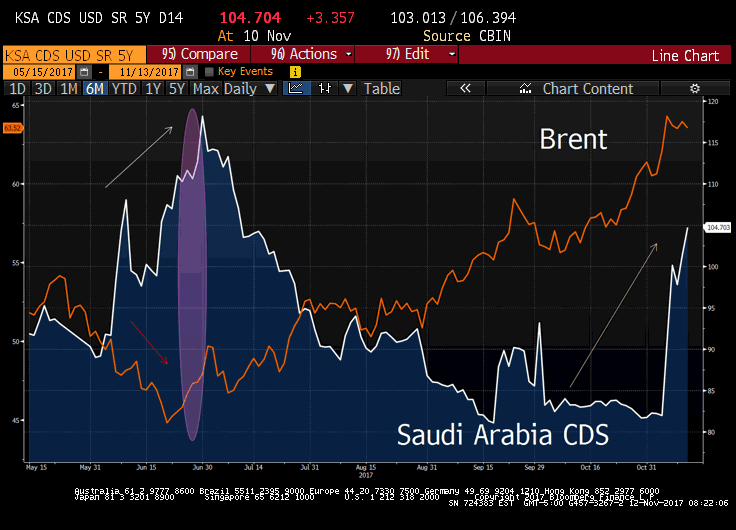 The cost of insuring Saudi Arabian debt from default is approaching two-year highs, even as oil prices globally are ripping upward. On our Bloomberg terminal, five-year CDS soared another 20 basis points last week. On the heels of a destabilizing “anti-corruption” purge in the kingdom, credit risk is on the rise. Increasing tensions with Hezbollah, an Iranian-backed militant group, have compounded investor concerns about rising political risks in the region. The last time the nation’s CDS jumped as much in a single week was in January 2016 at the height of the oil-market crash. Back then, Brent was $27, compared to $64 last week. The Kingdom’s debt profile has broadly expanded. Public debt outstanding in 2014 was down at $44B, today she’s approaching $300B, per Bloomberg data.
The cost of insuring Saudi Arabian debt from default is approaching two-year highs, even as oil prices globally are ripping upward. On our Bloomberg terminal, five-year CDS soared another 20 basis points last week. On the heels of a destabilizing “anti-corruption” purge in the kingdom, credit risk is on the rise. Increasing tensions with Hezbollah, an Iranian-backed militant group, have compounded investor concerns about rising political risks in the region. The last time the nation’s CDS jumped as much in a single week was in January 2016 at the height of the oil-market crash. Back then, Brent was $27, compared to $64 last week. The Kingdom’s debt profile has broadly expanded. Public debt outstanding in 2014 was down at $44B, today she’s approaching $300B, per Bloomberg data.
